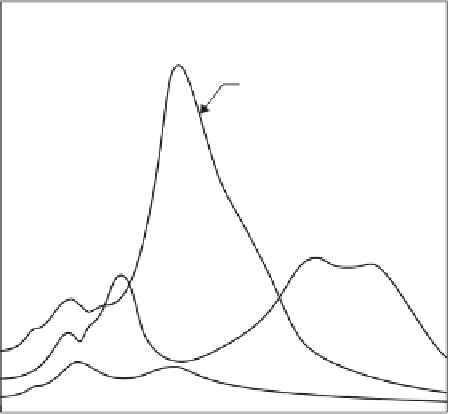Environmental Engineering Reference
In-Depth Information
the valley. This difference would probably result in intensities of VII in the lacustrine soils
and VI in the sand and gravel. The spectral accelerations (PHGA) recorded during the
September 19, 1985 Mexico City event for various subsurface conditions are given in
Figure 11.19
(Response Spectra,
Section 11.4.4
).
Since the earthquake epicenter (
M
8.0)
was approximately 400 km distant from Mexico City, the rock and hard soil spectral accel-
erations were less than 0.1
g
. At sites SCT and CAO, underlain by deep deposits of typical
Mexico City soft clays and sands
(Figure 7.60),
it is shown that soil amplification was three
to six times the rock response. The buildings at the CAO site generally had fundamental
periods outside of the recorded periods and suffered minor damage. The buildings at the
SCT site, however, had fundamental periods similar to the recorded periods, of the order
of 1 to 2 s, and suffered major damage and even collapse (Bray, 1995).
Ground-motion records from a peat layer in Seattle showed that motion was amplified
for a distant event (150 mi) but attenuated for one nearby (Seed, 1970). A possible expla-
nation may be that the seismic waves from the distant event pass parallel to the layering
in the peat, whereas those from nearby areas pass upward through the peat (the effect of
different period characteristics).
Foundation Depth
Ground motions are usually given for the surface but design requires ground motion at
the foundation level. Seed et al. (1975) present data showing that during the Tokyo-
Higashi-Matsuyana earthquake of July 1, 1968, accelerations recorded for structures near
the ground surface were on average about four times larger than for buildings founded at
a depth of about 24 m.
Source Distance
The amplifications at close distances from the source appear to be more influenced by
topographic expression and geologic structure than by local soil conditions. For large epi-
central distances from the source, however, local amplification can be considerable, as it
can be for motions of smaller intensities and stratigraphies characterized by sharp con-
trasts of seismic impedance (Faccioli and Rese
′
ndiz, 1976).
0.9
5% Damping
0.8
SCT site
(depth to hard layer,
D
= 37 m)
0.7
0.6
0.5
CAO site
(
D
= 58 m)
0.4
0.3
0.2
FIGURE 11.19
Acceleration response spectra for
motions recorded in Mexico City during
the 1985 event. (After Seed, H.B. et al.,
Earthquake Engineering Research
Center Report No. UCB/EERC-87/15,
University of California, Berkeley, 1987.)
Rock and
hard soil
0.1
0
0
1
2
3
4
5
Period (sec)

















